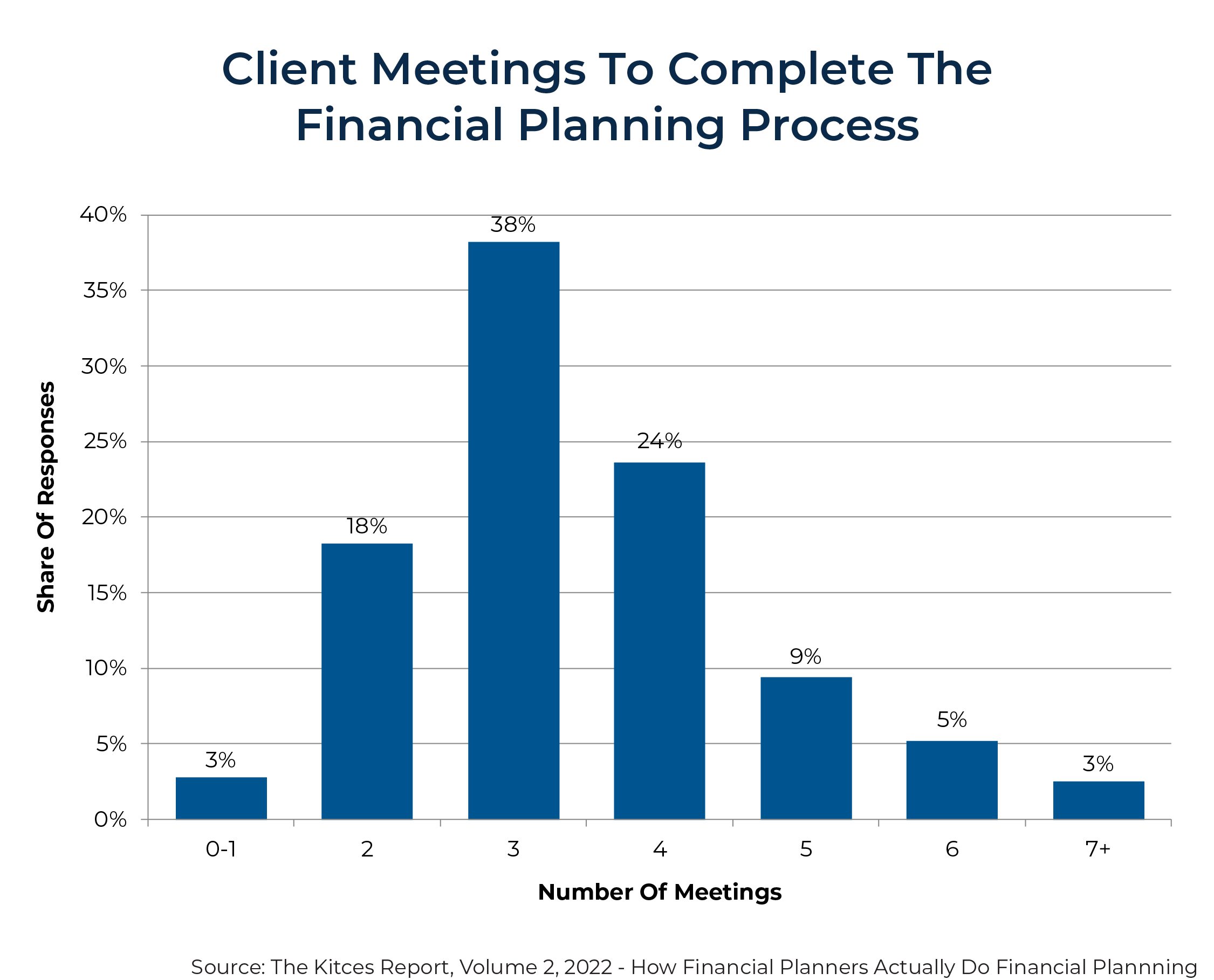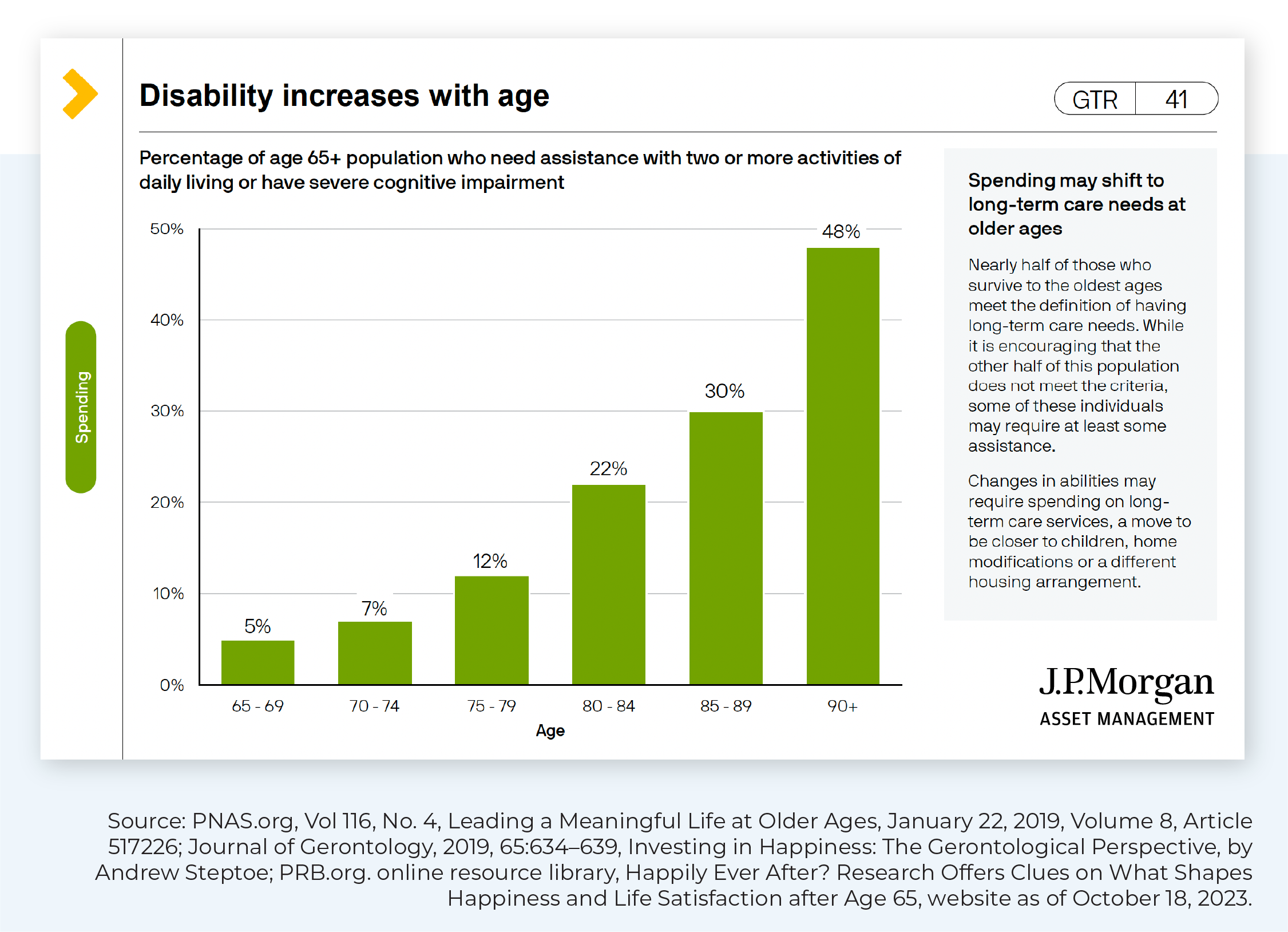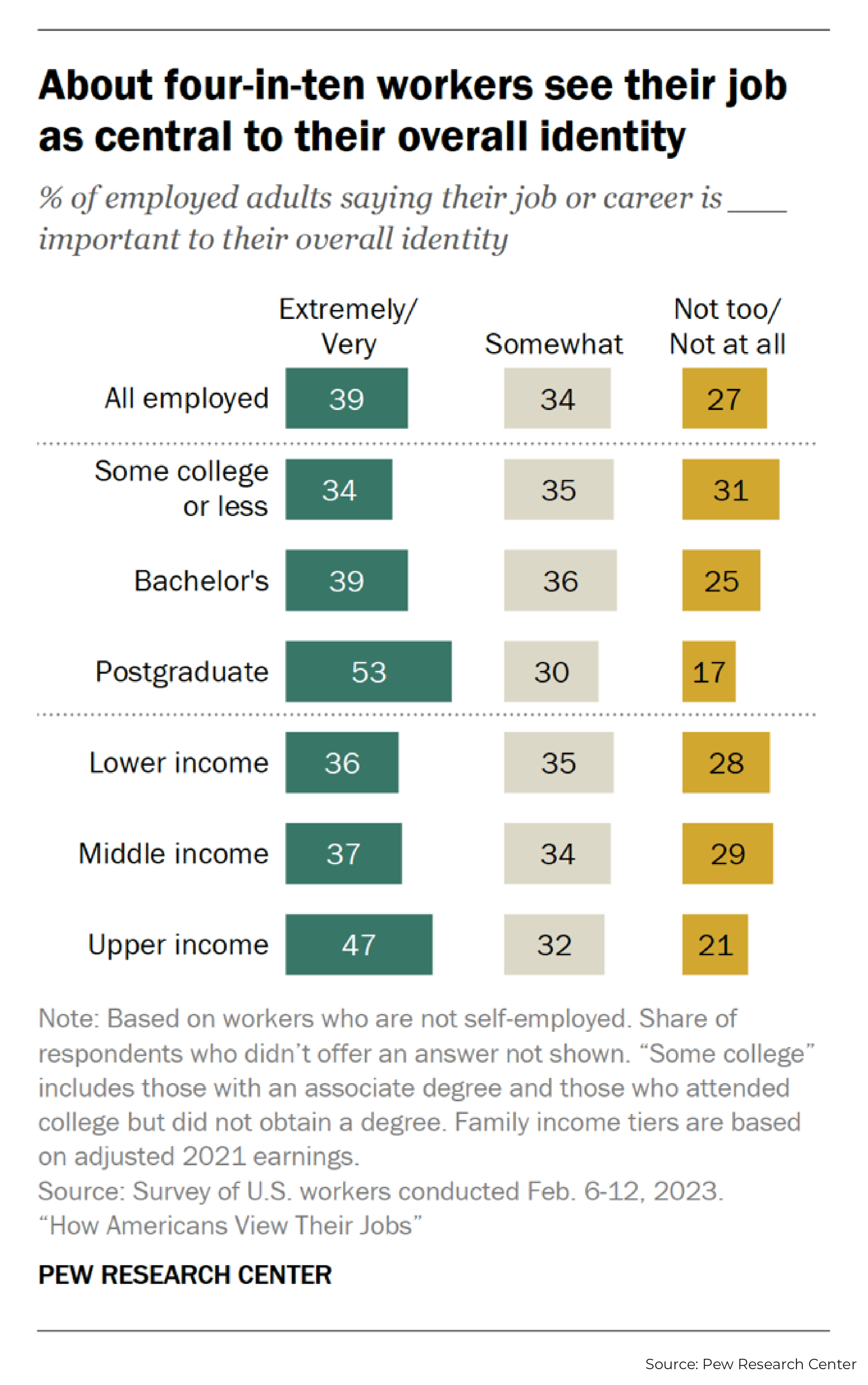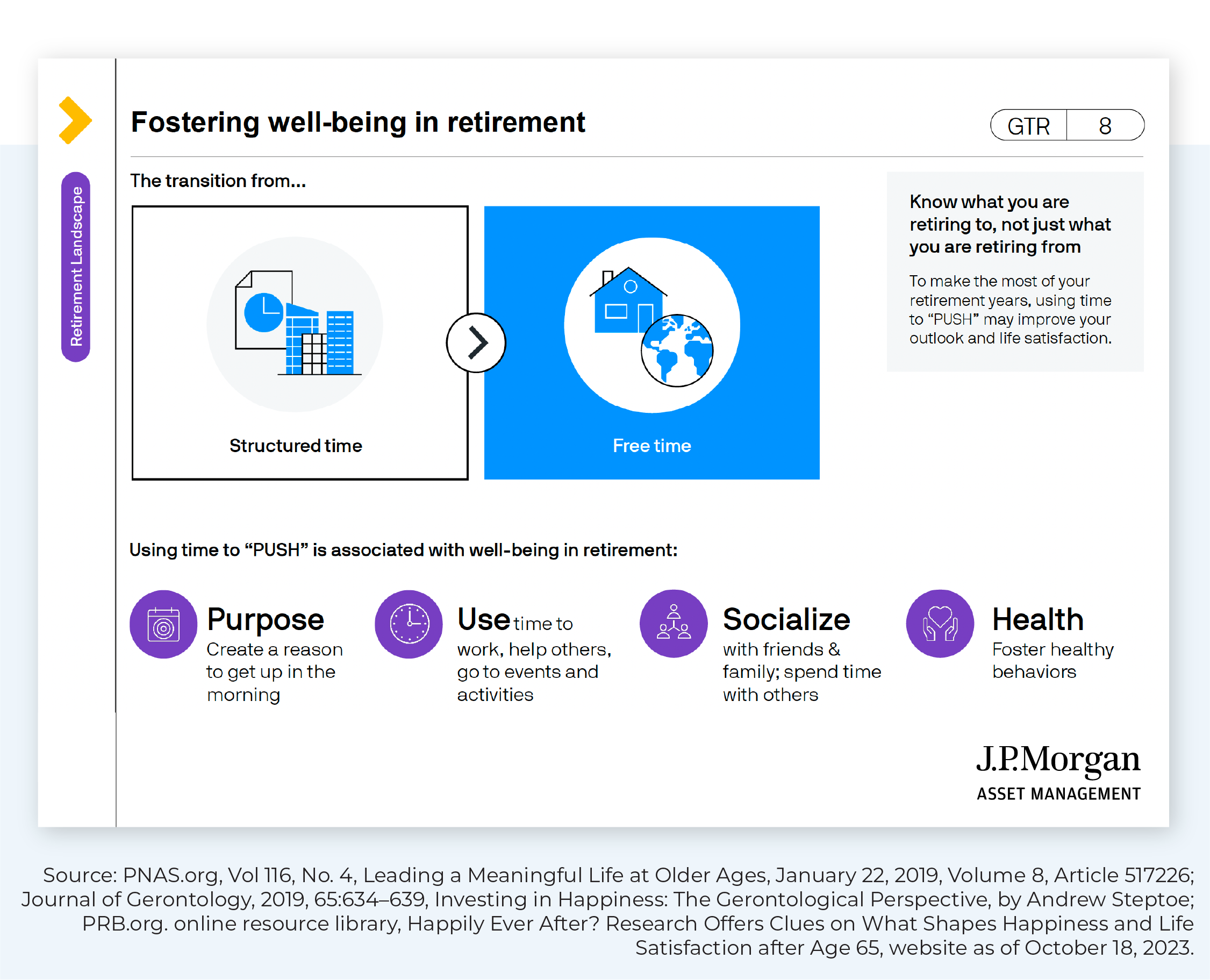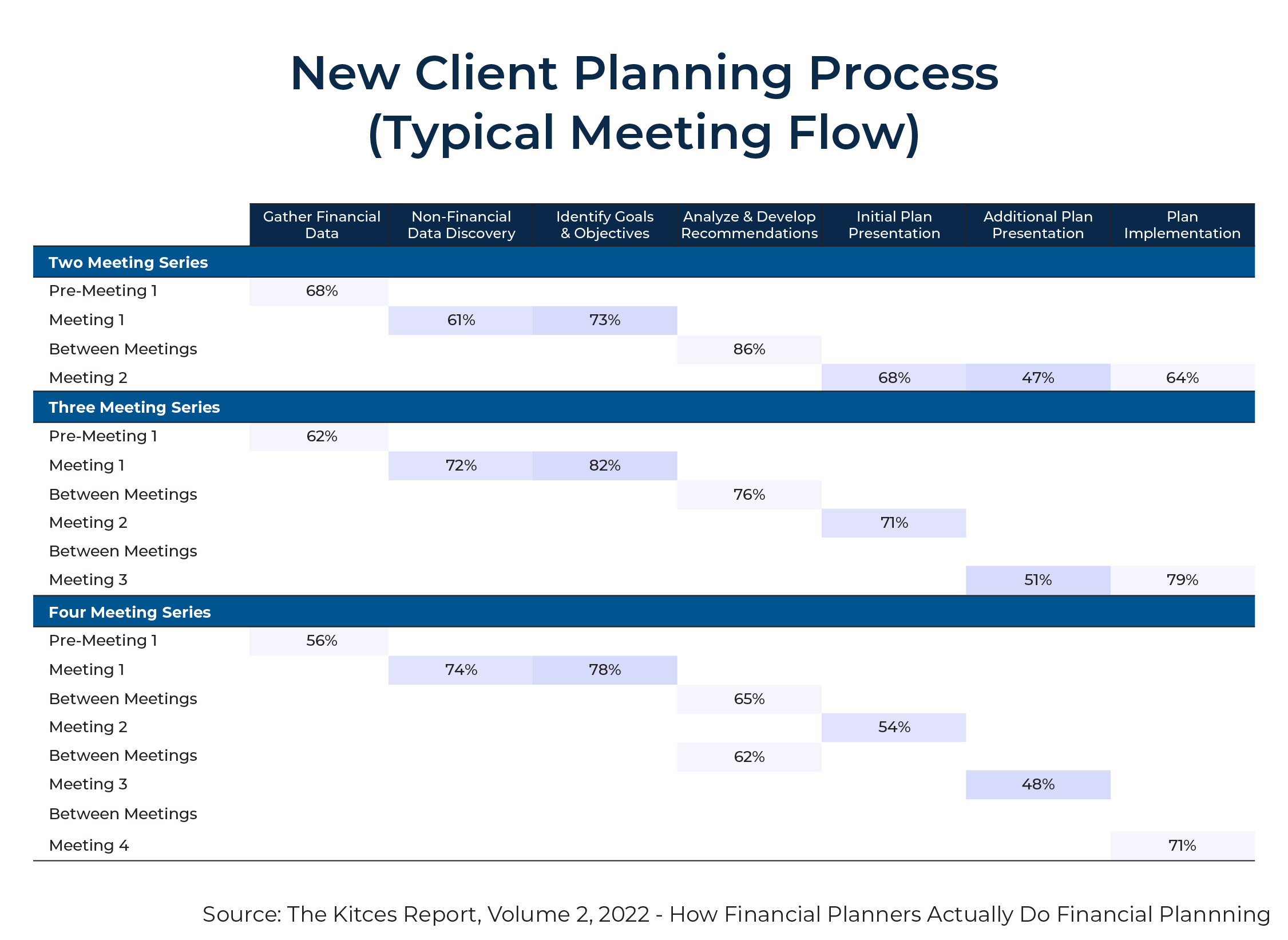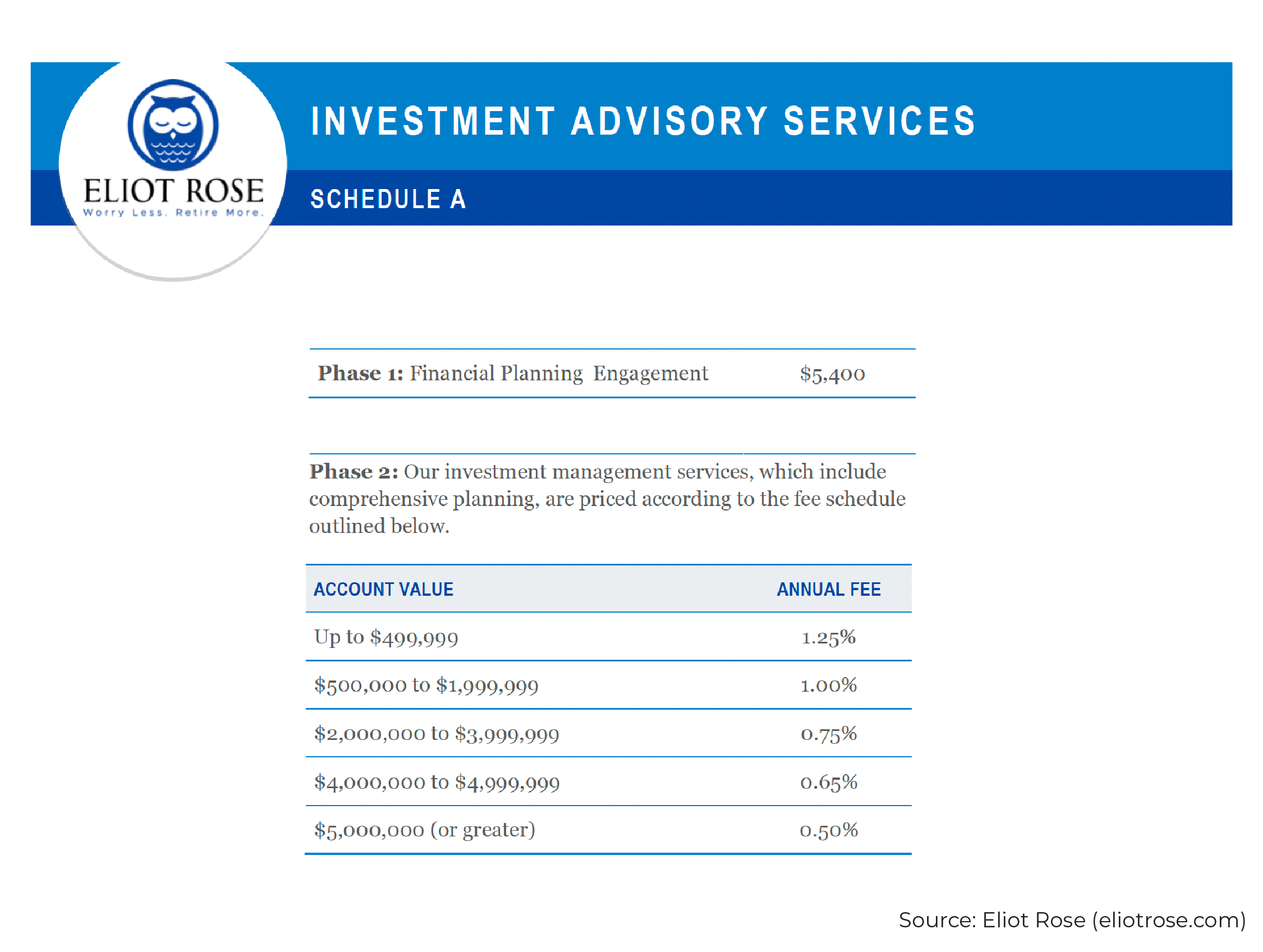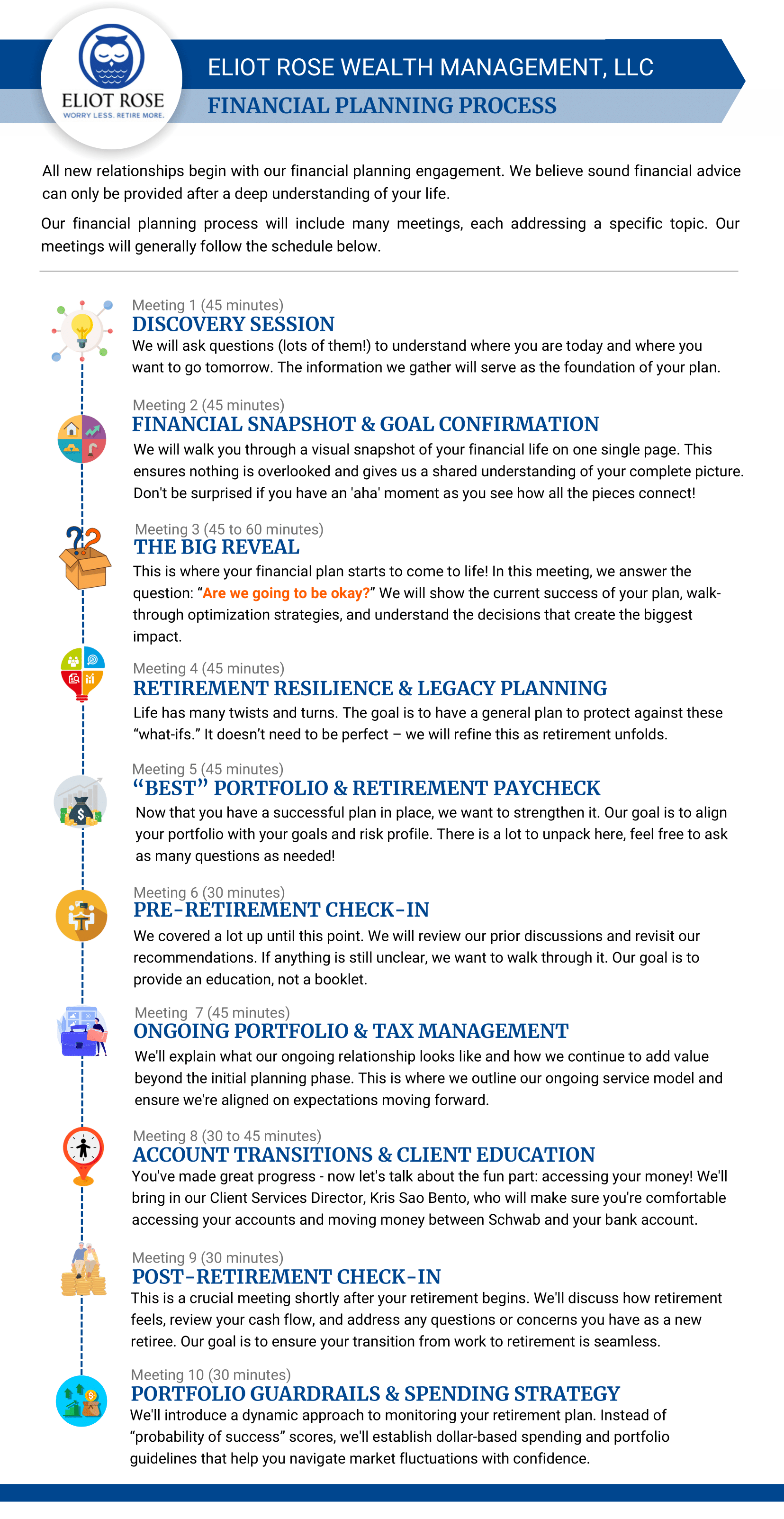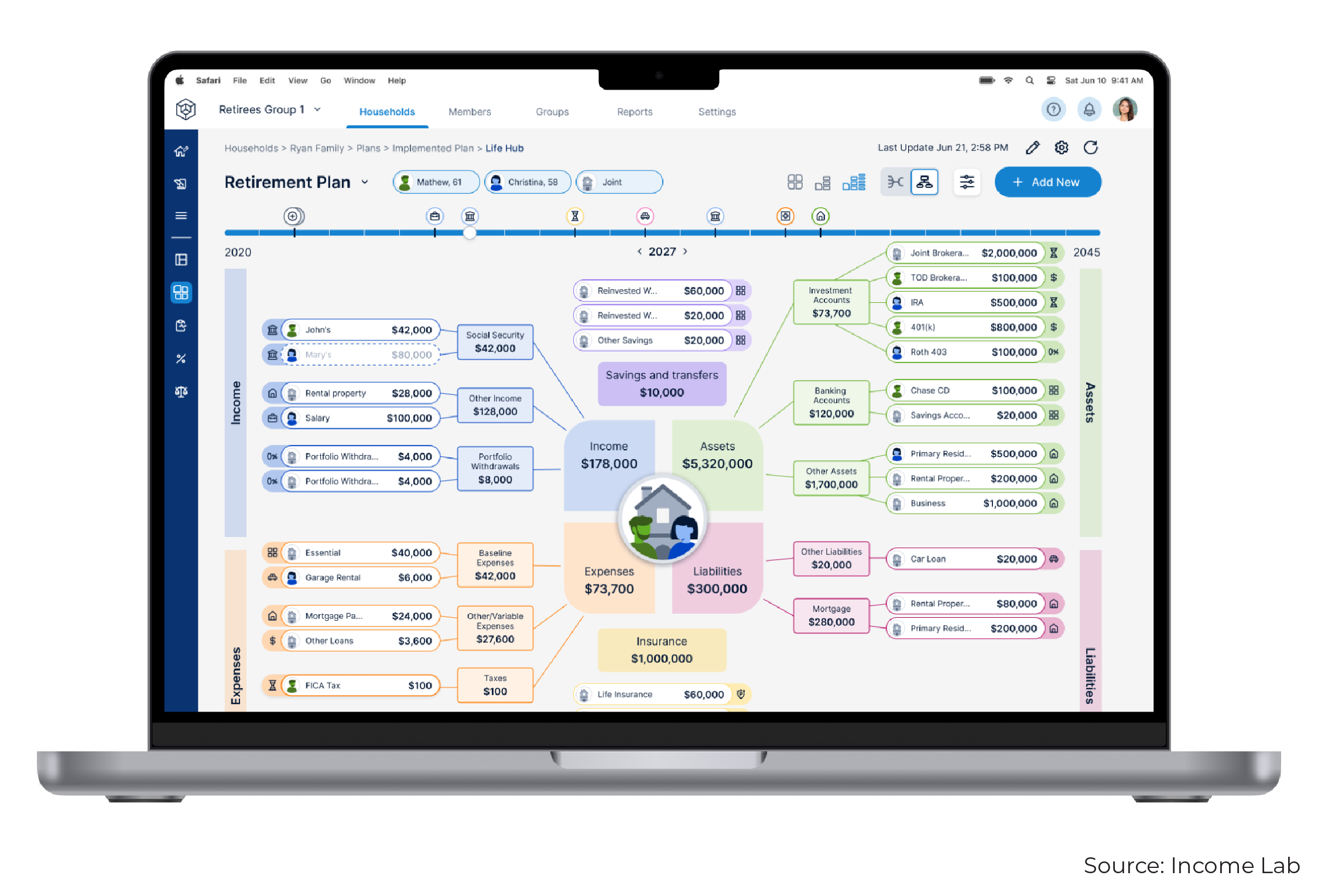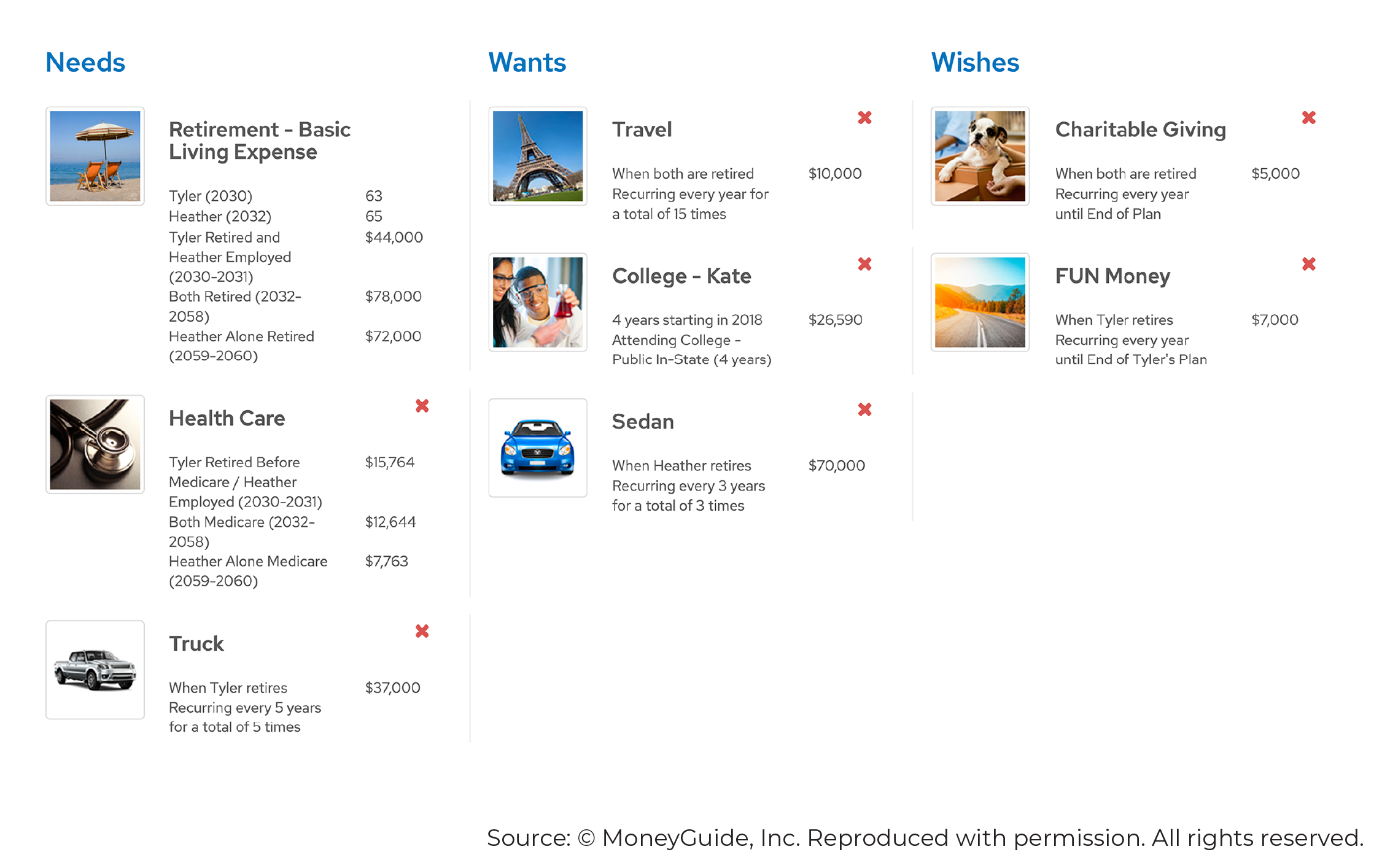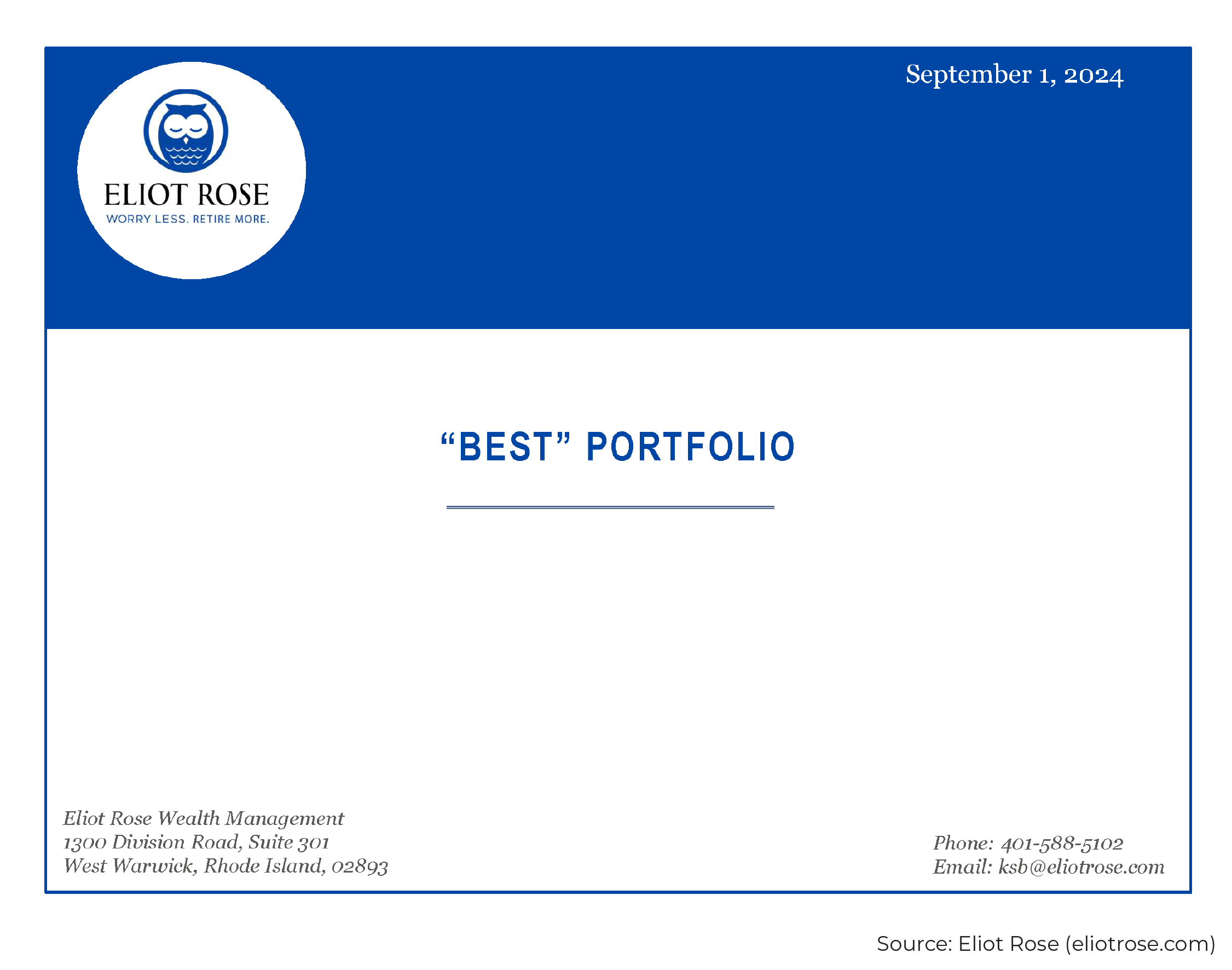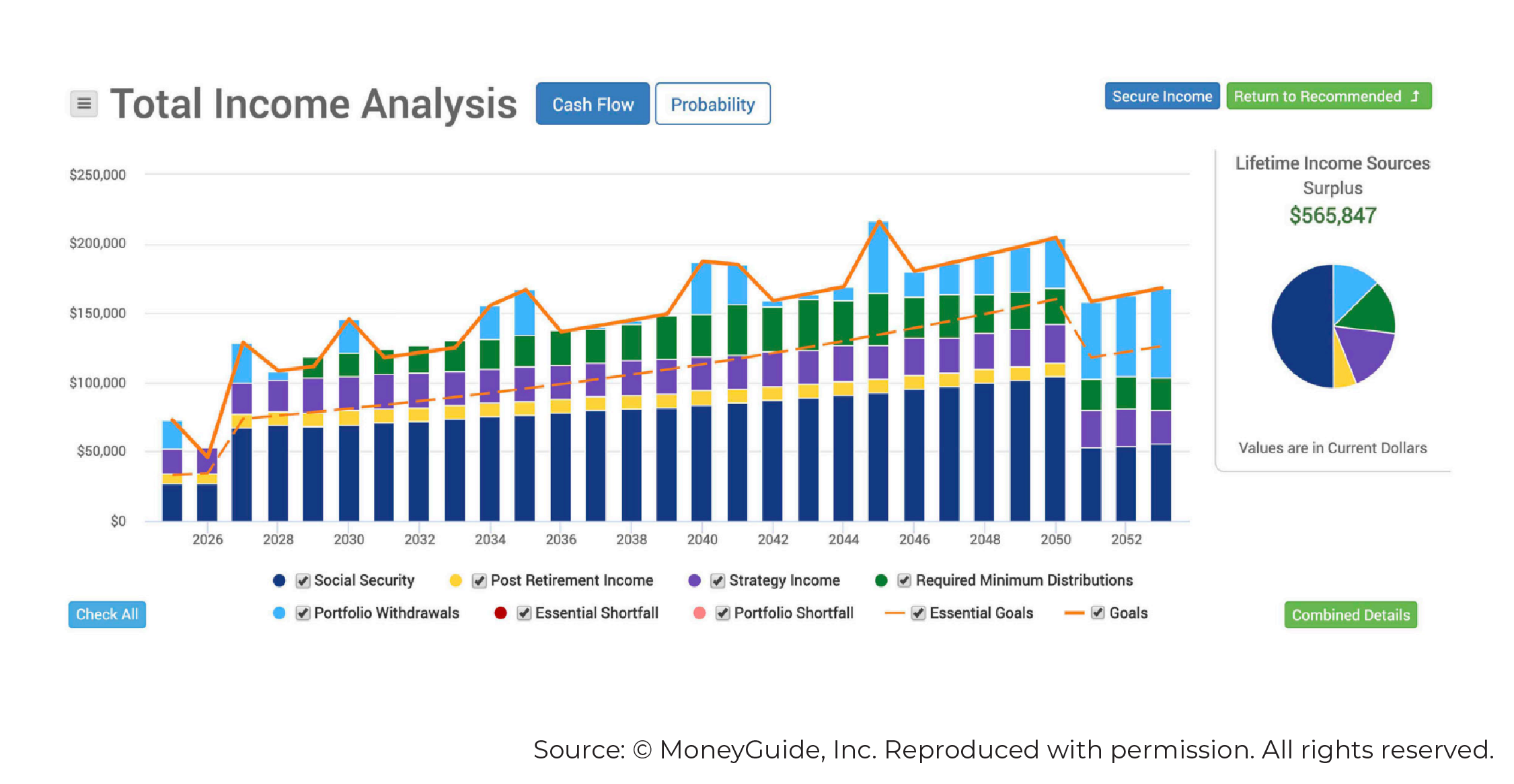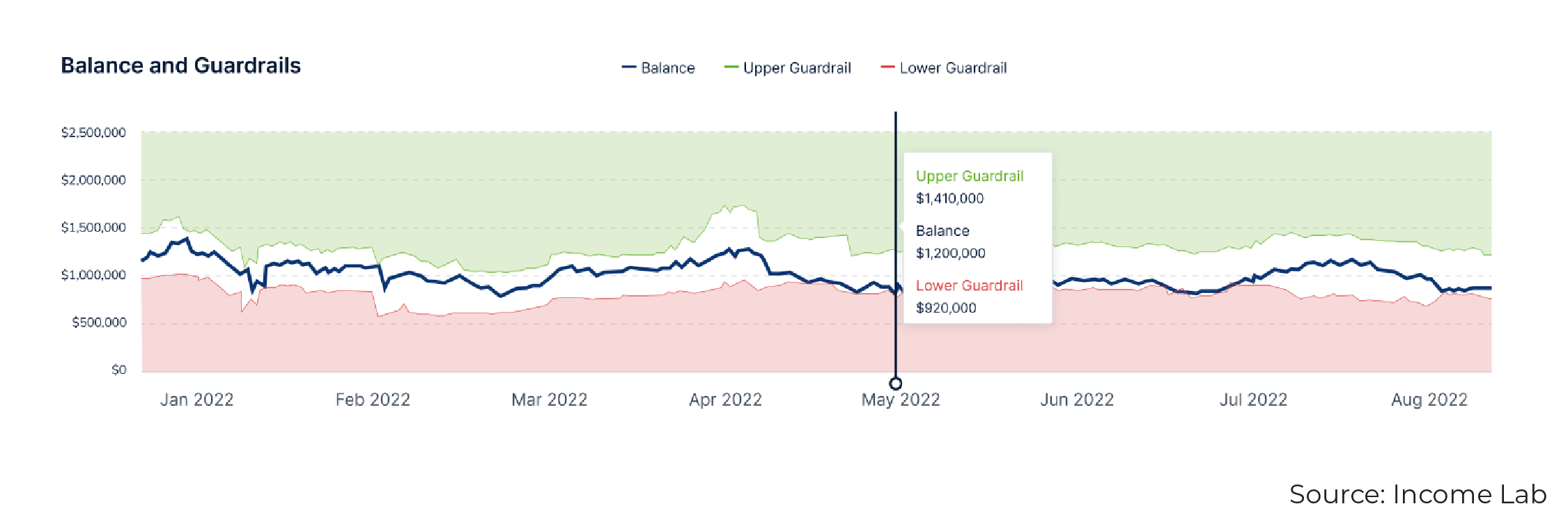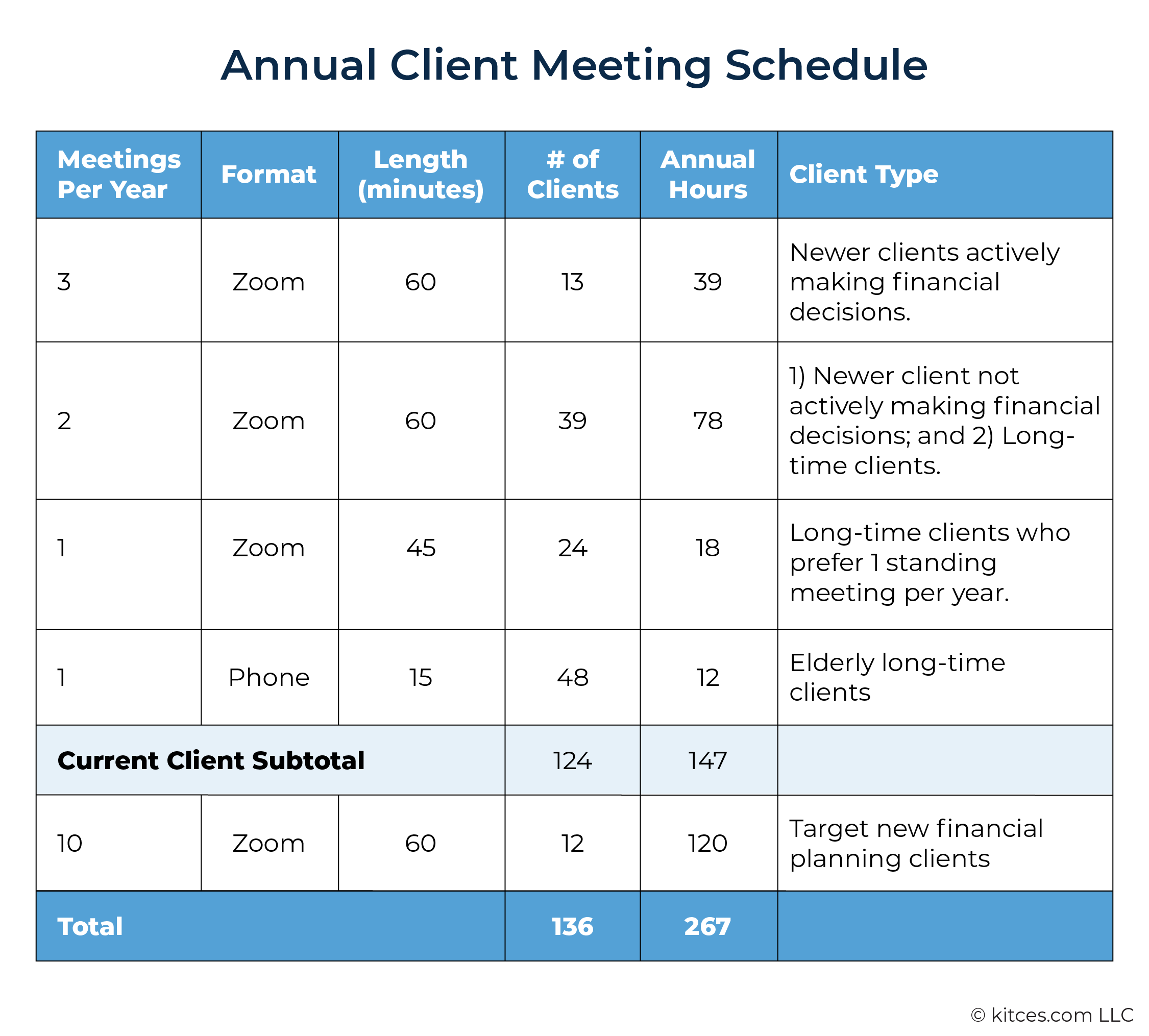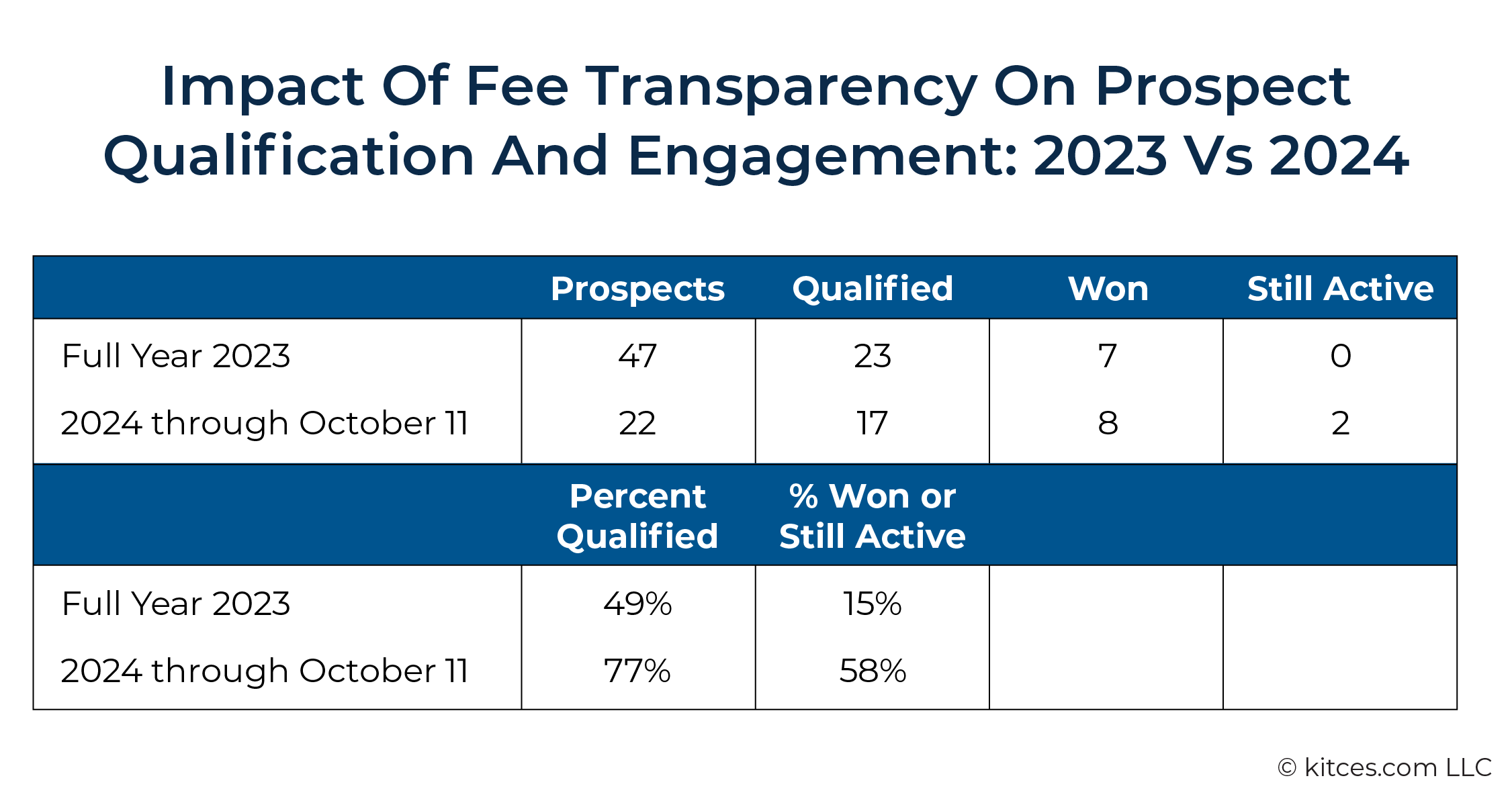Executive Summary
When onboarding new clients, financial advisors often use a three-meeting cadence: a Discovery Meeting to gather information, a Presentation Meeting to discuss the plan, and an Implementation Meeting to finalize it. While this approach works for many clients, individuals who are 12 months away from retirement face a range of complex financial and emotional considerations. These clients may benefit from a more thorough process to address their unique needs, from critical financial decisions to the logistical and emotional challenges of redefining life after work.
In this guest post, Jason Siperstein, president of Eliot Rose Wealth Management, introduces his firm's innovative 10-meeting process for first-year clients nearing retirement. By dividing the planning into more focused, manageable sessions, Jason's approach gives clients space to address pressing questions like, "Can I afford to retire?" while also setting the tone for a long-term planning relationship built on trust and deeper client engagement.
Jason's process begins with a Discovery Meeting, where he forgoes pre-meeting questionnaires in favor of a more interactive, conversational approach to uncover nuanced insights into clients' goals and concerns. Subsequent meetings build on this foundation by providing clarity on financial data and priorities, introducing actionable strategies such as retirement income guardrails, and stress testing plans to ensure they remain sustainable under various scenarios. The process also includes critical discussions around estate planning and the emotional and social aspects of retirement, recognizing that this major life transition can involve new goals as clients adapt their purpose and identity to a new lifestyle.
A key factor in the success of this process is the intentional structure that Jason has developed to keep the client experience both high-touch and efficient. By setting aside Wednesdays to work 'on' the business rather than 'in' it, Jason's team continually refines the firm's workflows and processes. This focus on incremental improvements ensures a seamless client experience while maintaining the personalized service that sets his firm apart. In addition, Jason's team has built flexibility into their process, tailoring the ten-meeting structure to meet the unique needs of each client, whether they require more detailed exploration or a streamlined approach.
Ultimately, the key point is that clients facing major life transitions, such as retirement, benefit from a deeper and more structured planning process. By providing clients with a clear roadmap for retirement, reducing uncertainty, and providing a sense of control during a pivotal time in their lives, advisors can set the stage for a planning relationship built on trust and long-term collaboration. Which also gives advisors the opportunity to deliver significant value by addressing both the financial and personal priorities of a client's retirement, helping clients move forward with confidence and excitement as they embrace the next chapter of their lives!
I once spent three hours watching YouTube videos about the immortal jellyfish, Turritopsis dohrnii.
I didn't plan to… I was trying to keep up with current events but fell down the YouTube rabbit hole. Curiosity has always been one of my defining traits. While it isn't always efficient, it does come with some advantages (or so I tell myself!).
This same curiosity kicked in when my firm was struggling to find its footing back in 2016. We tried everything – different marketing strategies, attempting to recruit and acquire, even mastering cryptocurrency (spoiler alert: almost nothing worked!).
Eventually, though, as our firm found its footing, we also honed in on our niche:
- People 12 months away from retirement
- Who want both planning and investment management
- With investable assets of $1 million or more.
We've come to call this critical 12-month period before retirement the "Leap Year" – partly because it's as rare as February 29th, and partly because it symbolizes a significant leap into the next chapter of our clients' lives.
But finding our niche was only the beginning. As we started working with more of our ideal clients, we had our 'aha' moment – the standard first-year financial planning process we'd always used before was way off base for them.
A 2023 Kitces report found that about 80% of advisors follow a schedule of two to four meetings that typically include Discovery, Plan Presentation, and Plan Implementation meetings.
It's a time-tested method that works for many clients... just not ours.
For our Leap Year clients – those who are 12 months away from retirement – the popular three-meeting process felt like trying to use a ruler to measure a mile. It seemed totally insufficient for someone staring down the barrel of a major life transition.
So, we started to question everything about the standard financial planning process. We found ourselves asking:
- Why doesn't this first-year planning approach work for our clients?
- What makes the 'Leap Year' so different that it requires a rethink of the standard process?
- How would we want to be advised during our last year of work?
Each answer led to more questions, forcing us to reevaluate our entire planning process for these clients.
And down another rabbit hole we went…
After months of questioning, research, and countless cups of coffee (matcha for me), we finally understood something now glaringly obvious – the year before retirement isn't just another year. It marks the deliberate decision to close a 40-year career chapter and embark on 30 years of something entirely new. Talk about pressure!
So, we did what any curious, slightly obsessive team would do – we built a new process from the ground up.
A Perfect Storm of Challenges
As we developed our new playbook to serve the unique needs of our Leap Year clients, it became clear why the standard year-one meeting approach to building a financial plan falls short. We're dealing with a perfect storm of challenges.
As advisors, we're not just facing the usual financial projections. Suddenly, we're racing against real, rigid deadlines such as pension decisions that can't be postponed, Medicare sign-ups with penalties if late, and 401(k) plan rollovers that need careful coordination. All of these things while clients struggle with the emotional weight of leaving their careers, their routines, and possibly their friends. This transition requires us to combine our technical planning expertise with skills similar to those of life coaches, therapists, and mentors highlighting that our role goes beyond 'just' money; it's about helping our clients navigate major life changes.
For soon-to-be retirees, once-distant worries transform into looming realities. Suddenly, questions like "What if I get sick?" are no longer fleeting thoughts, they're the reason clients are flipping through health insurance policies at 2 AM to understand their coverage provisions. And for good reason – disability increases significantly every five years for this demographic.
Additionally, answering the question, "What if my spouse dies first?" now takes on a new sense of urgency. Believe it or not, the median age for married women who become widows has been reported to be only 59.4 (and while there aren't specific median age data for men, it is interesting to note that 80% of men die married, while 80% of women die single). Each hypothetical outcome becomes a task, and each worry becomes an action item. Health issues take the forefront, influencing decisions from living arrangements to daily activities. The once vague concept of 'aging' becomes very real, very fast.
And then there is the unknown. Our industry has spent decades communicating how to achieve wealth, with every book, seminar, and piece of advice reinforcing the message: save, save, save. But retirement flips this script entirely – suddenly, the new name of the game shifts to spending. And, as a whole, advisors have not been nearly as good at communicating this message.
There's a striking absence of frameworks for managing spending in retirement, making it a challenge not only for retirees but also for those in the industry. We've created an environment where saving money feels safe and spending money feels scary. This oversight has been a blind spot in our profession: While we've mastered the art of saving, the strategies for spending remain underdeveloped. It's only recently that financial advisors, thanks to the contributions of retirement thought leaders like Justin Fitzpatrick, Derek Tharp, and Jamie Hopkins, have begun to address this crucial issue.
The Retirement Paradox
Retirement planning has a funny way of creating unexpected outcomes. A 2016 study published in the Journal of Financial Planning, "Spending in Retirement: Determining the Consumption Gap," revealed a counterintuitive trend. The wealthiest retirees – those in the top quintile – often end up wealthier in their 80s than in their 60s.
These individuals aren't lottery winners or tech billionaires; rather, they're often the unassuming millionaires next door who are typical clients of advisors. This accumulation of wealth in advanced age creates a strange situation. Rather than depleting their funds, these retirees face the challenge of spending their accumulated wealth, inadvertently trading the stress of saving for the stress of spending. For these individuals, the challenge isn't running out of money, but rather running out of time to enjoy their lifelong savings.
Moreover, conventional retirement strategies often fall short. Take the 4% withdrawal rule for instance. It was originally created as a guideline to prevent depleting one's savings in a worst-case scenario, not as a rigid spending rule. In fact, in over two-third of cases, retirees following this rule actually end up with more than double their starting wealth, on top of the 4% they've been withdrawing each year. And retirement spending patterns are anything but smooth. They tend to be lumpy – initially high during the early years of retirement, then declining as Social Security is claimed and retirees enter the 'slow-go' phase rendering the 4% rule generally impractical from an implementation standpoint.
Monte Carlo simulations are a big improvement and account for irregular spending, but can inadvertently compel the wrong client actions. For instance, showing an "85% success rate" may sound great until clients ask about the potential implications of the remaining 15% of the time they fall short. Since we are all conditioned to want the A+ grade, many clients (consciously or subconsciously) aim for a 99% probability of success and all but guarantee they underspend. The real problem, though, is that these simulations are not actionable plans. Instead, they provide observations with an uncomfortable amount of uncertainty leading retirees to accumulate significant unspent wealth by the end of their lives.
As noted before, the point is that retirement isn't 'just' a financial event. It represents a profound shift in how people live, think, and interact with the world around them. Money is just the backdrop. The real story of retirement revolves around managing time, exploring purpose, and shaping one's identity.
The Identity Crisis
A 2023 Pew Research Center survey found that 73% of Americans view their careers as at least somewhat important to their overall identity. Not surprisingly, the significance of career identity increases with education and income levels – a demographic that typically includes many of a financial advisor's clients.
For decades, work has provided a built-in structure for most people's days, shaping their schedules, social circles, and often, their sense of self. Then suddenly, it doesn't. Upon retirement, individuals are faced with an additional 2,500 hours each year – hours previously occupied by meetings, commutes, and office or Zoom banter.
This sounds great in theory – Freedom at last! But, in reality, it can be scary. Many new retirees find themselves adrift, wrestling with a loss of purpose, a shrinking social circle, and the lingering question, "What now?" It's like being a teenager again, but with better finances and a worse back!
Retirement isn't just about filling newfound time – it's also about finding meaningful ways to spend it. And this pursuit of meaning is a whole different challenge than making the numbers work.
The question, "What do you do?" is often one of the first questions posed in social settings across the United States. For retirees, this can be a tricky prompt. Pre-retirement, the answer was simple, rehearsed, automatic. "I'm a teacher." "I work in tech." "I run a small business." These replies did more than just answer the question; they provided a quick way to establish categories and connections.
Replying with "I'm retired" might seem to lack depth, providing no springboard for further conversation or clues about personal interests or expertise.
Some retirees find this new self-definition challenging, hesitating as they search for the right words. Others might overcompensate by launching into lengthy explanations of hobbies or volunteer work, eager to share their new pursuits. We've likely been on the receiving end of that conversation, nodding politely, perhaps even trying to find a tactful exit from the discussion.
Relationships shift, too. Couples who've spent decades with separate work lives suddenly share space 24/7. It's a second honeymoon for some, a shock to the system for others. Family dynamics change. Some retirees see their adult kids more and may realize they're not sure how to connect outside of holiday dinners.
Then there's the unplanned role of grandparent-as-babysitter. While it might sound fun at first, this responsibility can quickly become overwhelming. It's not uncommon for grandparents to find themselves caring for grandchildren three or four days a week, effectively taking on a part-time job they never applied for (not to mention the extra cost)!
The reality is that a person can have a perfect financial plan yet still struggle with retirement. Because while money is necessary, it's not sufficient for a fulfilling retirement. It can't buy purpose. It can't create meaningful relationships. And it can't provide a renewed sense of identity.
Reimagining the Advisor's Role
Confidence in retirement is often centered on financial security – and for good reason. However, effectively managing time and figuring out how to spend it are equally important. And for advisors concerned about fee compression, helping clients write this next chapter of their lives can represent a huge value creator.
There's a fascinating parallel I've noticed between our work as financial advisors and the field of psychotherapy (disclaimer: my wife is a psychiatrist). The American Psychological Association (APA) has long emphasized that the strength of professional relationships is a crucial factor in positive outcomes. This principle, well-established in therapy, is equally vital in financial planning.
In therapy, when a patient trusts their therapist, they don't just talk, they share deeply. They open up, even at the risk of sounding foolish, because they feel safe in that space. Similarly, in financial planning, trust is critical. Without it, clients may hold back, leaving important questions unanswered and concerns unaddressed. Worries tend to multiply and the advice they are given is not followed.
Typically, the first-year meeting structure for advisors follows a three-meeting process that looks something like this:
- Discovery
- Plan Presentation
- Implementation
Clients come with a bucket of money that took 40 years to build and a head full of questions:
- "Can we afford to take the family to Italy?"
- "What if I worked one more year?"
- "Is gifting $15k to each kid fair when they have different needs?"
- "Do I need a Trust, or is that just for 'rich' people?"
These aren't yes or no questions; they're invitations to explore more deeply and they deserve thoughtful consideration.
As we all know, Planning can be messy and iterative. It includes the panic calls about forgotten inheritances, the impromptu analyses of whether a client should stick with their company health plan or switch to Medicare, and mediating discussions like the "Buy a Vacation Home versus Airbnb" debate among spouses.
For our Leap Year clients, the "plan presentation" never ends up taking just one or two meetings. At our firm, it's an ongoing process at the beginning of the engagement. In our experience, the true value we provide as "advicers" manifests in the what-ifs, the follow-ups, and the moments when we help clients who need to start over – no matter how many 'startovers' are involved.
Here's something that blew my mind: A 2016 study from University College London found that knowing there's a small chance of receiving a painful electric shock can be more stressful than the certainty of one. Oddly enough, the most stressful scenario was a 50/50 chance of shock, while the certainties of 0% and 100% were the least stressful. It seems our brains are wired to hate uncertainty even more than actual pain.
This insight is crucial in our approach to financial advice, which is why we aim to educate our clients with knowledge that actually moves the needle. We don't want to add uncertainty – we want to reduce it as much as possible. So, instead of offering abstract probabilities of retirement success – which can be helpful for clients further from retirement who have ample time to adjust their pre-retirement planning – we provide our Leap Year clients with concrete anchors:
- "Your lifestyle is safe unless your portfolio drops below $1.3 million."
- "Your neighbor's annuity might be great for her but let me show why it doesn't make sense for you."
- "Yes, markets are down, but this is a normal cycle that occurs every few years."
When a client understands the "whys" and "hows", things become clear, and they feel safe. This level of detailed, personalized guidance goes beyond what is typically accomplished in the standard three-meeting process.
Our (Year-Long) Financial Planning Process
As author and speaker Simon Sinek would say, "Apple doesn't sell phones. Disney doesn't sell rides. Ritz-Carlton doesn't sell beds." These iconic brands are not just selling products; they are really selling experiences, cleverly disguised as commodities.
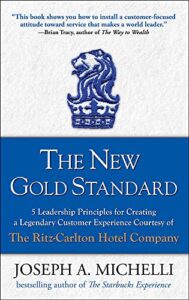 I think that the true genius of these companies isn't in the products they make, but in the feelings they evoke. It's seen in the Apple employee who spends an hour helping your grandma set up her first smartphone, making her feel embraced by technology rather than intimidated by it. It's the Disney character who pretends your daughter's stuffed animal is a VIP guest, turning a simple visit into a magical, unforgettable adventure. And it's the Ritz-Carlton staff who remember how you like your coffee even if your last stay was five years ago – a testament to their commitment to personal service (brilliantly described in "The New Gold Standard" by Joseph A Michelli, on creating exceptional customer experiences).
I think that the true genius of these companies isn't in the products they make, but in the feelings they evoke. It's seen in the Apple employee who spends an hour helping your grandma set up her first smartphone, making her feel embraced by technology rather than intimidated by it. It's the Disney character who pretends your daughter's stuffed animal is a VIP guest, turning a simple visit into a magical, unforgettable adventure. And it's the Ritz-Carlton staff who remember how you like your coffee even if your last stay was five years ago – a testament to their commitment to personal service (brilliantly described in "The New Gold Standard" by Joseph A Michelli, on creating exceptional customer experiences).
The memorable moments created by these companies aren't accidental. They're carefully crafted experiences designed to transform ordinary transactions into cherished memories. In a similar vein, our firm has taken this philosophy to heart: Experience is everything.
Like many advisors, our approach puts advice first. But perhaps unlike many advisors, we dedicate an entire year to understanding and optimizing a client's financial picture before we touch a single asset. One year of advice does something powerful – it disarms. In a world rife with pressure and the urgency to act, we've found that demonstrating patience sets us apart.
There's no pressure to invest, no commitment required, no logistical headaches, and no immediate asks – just comprehensive guidance designed to set the stage for financial success.
Our approach unfolds in two phases:
- Phase One: Full-Year Financial Planning Engagement – $5,400 fee
- Phase Two: Implementation – Tiered AUM fee
Phase One is the cornerstone of our entire process. It's where relationships are built, trust is established, and the groundwork for long-term success is laid.
During a client's first year with us – typically their "Leap Year" – we meet about 10 times to build and refine their financial plan. That's triple the industry standard! Is it the most efficient? No. Is it effective? Absolutely.
We didn't plan it this way. It just evolved from a desire to ensure our clients felt heard, understood, and educated. No investments are managed during Phase One. It's purely about planning, education, and relationship building.
One might think clients would balk at such a drawn-out process. "Who has time for 10 meetings? That sounds exhausting", they might think. But we position it as, "We'll be with you every step of the way during your retirement Leap Year." This reassurance transforms what might seem overwhelming into a supportive journey. And when facing a significant life change like retirement, people aren't looking for quick fixes. They're looking for a steady, guiding hand.
Recently, at the suggestion of a client, we came up with a planning roadmap document that we now send to clients right from the start. It's nothing fancy – just a simple visual guide that outlines our whole process (which we discuss in more detail below). It's designed to set clear expectations and provide a sense of direction. While it's constantly evolving as we make adjustments to refine our approach, the graphic below shows what it looks like today:
Clients really appreciate having this roadmap. They know exactly what's coming next, which means fewer "So... what happens now?" questions. Plus, this clarity has been great for us, too. There's no more trying to explain where we are in the process while simultaneously checking the CRM to remember.
We know that our process is not for everyone. And that is by design because to appeal to everyone is to appeal to no one. We refer out anyone who does not fit our niche, which we define as the following:
- People 12 months away from retirement,
- Who want both planning and investment management, and
- With investable assets of $1 million or more.
To do this, we hold a 15–20-minute Meet & Greet via Zoom. We understand that meeting with someone new, especially when discussing finances, can feel daunting, and we don't take that for granted. At the end of the meeting, if it becomes clear that we're not the right match, we'll refer the prospect to another advisor who might be better suited.
Initially, we felt guilty about turning people away and referring them out, but we've since learned that connecting them with an advisor who is better suited is not only the right thing to do, but ultimately serves the best interest of us and them.
A Detailed Look At Our Year One Financial Planning Process
Phase One of our financial planning process happens over a full year. It takes place entirely through Zoom calls and consists of the following ten meetings:
Meeting One: Discovery Session (45 minutes). Like most advisors, we begin with a Discovery Meeting, but our focus here is on life, not numbers. This standard first step is pivotal as it sets the tone for our entire relationship. We choose to skip data entry questionnaires for two key reasons:
- Experience: We want to provide a seamless and engaging experience – and do as much as we can to keep the 'homework' to a minimum.
- Capturing Nuances: Face-to-face interactions allow us to pick up on nuances that static forms simply miss.
We've found that people don't always know what they want until they start talking about it. The primary goal of the Discovery Meeting is to uncover the story behind the numbers. It's not only about what clients say, but also how they say it. Body language, tone, and hesitations can often reveal more than words alone. It's during these conversations that differences between spouses often emerge, sometimes showing that one partner's idea of retirement looks quite different from the other's.
Meeting Two: Financial Snapshot and Goal Confirmation (45 minutes). This meeting focuses on creating financial clarity and ensuring that we are fully aligned with our clients' visions. It's not uncommon for retirees to discover 'orphaned' accounts from jobs held decades ago. These accounts often get lost in the shuffle. Our goal is to ensure nothing slips through the cracks. For example, during a recent review of a client's tax return, we uncovered an old investment account they had completely forgotten about. This added $200,000 to their financial picture – proof that reading tax returns can (sometimes) be fun!
We also take this opportunity to double-check our understanding of the goals shared in the Discovery meeting. It's crucial that we accurately interpret client intentions because acting on misinterpreted goals can lead to misguided strategies. During this meeting, we use screen sharing to present graphics that offer clients a visual representation of their financial lives. This approach often helps clients see the full picture for the first time, frequently leading to 'aha' moments as they begin to connect the dots.
To confirm finances, we use Income Lab's Life Hub, which transforms complex financial relationships into an intuitive visual format. Rather than trying to piece together information from multiple statements and accounts, clients can see their entire financial picture at a glance. More importantly, it helps both members of the household participate equally in financial discussions and decision-making, regardless of their financial background.
While Income Lab plays a role in gathering and organizing financial data early on, the focus during the first several meetings is on MoneyGuide, which excels at supporting initial retirement planning and goal-setting. As the discussion shifts to potential adjustments and ongoing planning, Income Lab's spending guardrails take center stage, making it easier to address adjustments proactively and maintain client trust by avoiding surprises, like a significant drop in the plan's probability of success during a market downturn.
By the end of this meeting, we'll have a shared vision of a client's intended future along with the financial resources to make it happen.
Meeting 3: The Big Reveal (45–60 minutes). While the CFP Board would refer to this as the Plan Presentation meeting, for us, it represents one piece of a larger presentation process. At this stage, we zero in on the central question that keeps clients up at night: "Are we going to be okay?" This is a pivotal moment for retirees transitioning away from a regular paycheck. We don't give a simple "yes" or "no" – we focus on explaining the why and how.
We spend most of this session using MoneyGuide to examine the sustainability of their plan. By walking through cash flow charts that illustrate their financial future, we help clients visualize several alternate retirement scenarios, showing clients what's possible and exploring different outcomes. Often, this inspires clients to think bigger and potentially add new goals to their plan.
Conversely, if things are tight, we figure out what might need to be adjusted. This is why I view the plan presentation as more of an ongoing conversation – a beginning rather than nearing the conclusion of our engagement. Since most clients need time to absorb this information and consider which path best suits their situation – particularly after seeing whether they're overfunded or underfunded – we hold off on running stress tests for their updated plan until the next meeting. In the meantime, shortly after this meeting, we reach out to the client to ensure we are meeting their expectations and addressing questions and concerns promptly. Clients really appreciate this check-in – even if everything is going well.
Meeting 4: Retirement Resilience & Legacy Planning (45 minutes). This meeting is about facing reality. We dive into financial risks and potential lifestyle adjustments that could impact our clients' futures. Using our planning software, we engage in a stress test – or as we often explain to clients, we 'break' the plan. We test against a variety of scenarios: dying early, living longer than expected, high inflation, long-term care needs, reductions in Social Security or pension income, and lower-than-expected market returns. Our goal isn't to instill fear, but to prepare clients, giving them the confidence and 'permission' to spend.
This approach often yields enlightening discoveries. For instance, clients may initially hold back on spending because they're afraid of various what-ifs. However, once they see these scenarios aren't as dire as imagined, they may feel more comfortable loosening the purse strings.
But we don't stop at the numbers. We also discuss practical matters like account titling and simple ways to bypass probate, including Transfer On Death (TOD) or Payable On Death (POD) designations on bank accounts. We often correct misunderstandings about estate documents; it's not uncommon to find trusts that were established but never funded or trust documents and other key documents stored in a safe that no one else knows about!
Meeting 5: 'Best Portfolio' & Retirement Paycheck (45 minutes). This meeting cuts to the heart of retirement planning: how to turn a lifetime of savings into a sustainable income stream (without annuities). We dive into the pros and cons of different portfolio strategies, but more importantly, we show how to actually fund retirement.
Most of this meeting revolves around a PowerPoint presentation we've developed, which can be downloaded here. In this presentation, we break down complex concepts into digestible pieces, showing the high-level impact of various decisions. Our approach is heavily influenced by Michael Kitces' 2016 article, "How DO You Measure Which Retirement Income Strategy Is Best?", taking insights and adapting them to our clients' specific needs.
One of the most powerful visuals we use during this meeting shows clients exactly where the cash for living expenses will come from year by year. This is the first time that many of our clients truly understand how their retirement will be funded. I often witness a visible shift in clients – their faces relax, and tension seems to melt away.
Meeting 6: Pre-Retirement Check-In (30 minutes). This meeting is exactly how it sounds. It is our chance to ensure that everything we've covered clearly fits together. We address any lingering questions or concerns. This is not just about reviewing information – it's another opportunity to show clients we are still here to support them as retirement approaches.
Meeting 7: Ongoing Portfolio & Tax Management (45 minutes). This meeting shifts gears to discuss what an ongoing relationship (Phase Two) with our firm looks like. Even though we would have explained this in the preliminary Meet & Greet session prior to the engagement, time has passed, and we want to make sure we are all on the same page.
We use a PowerPoint presentation to explain how we add value and what to expect beyond the initial planning phase (click here to view a downloadable version of our presentation).
Meeting 8: Account Transitions & Client Education (30–45 minutes). I'm not sure many advisors dedicate entire meetings to 'just' logistics. Is it boring? Yes. But we never take logistics for granted. What's routine for us is often uncharted territory for clients. The small stuff – knowing how to read a statement, understanding where their money is actually going (and how to receive that money) – these are things that clients truly value. These details, often overlooked, ease concerns about moving large sums of money and can make or break the client experience. It's the difference between a client who's confident and one who's second-guessing.
Meeting 9: Post-Retirement Check-In (30 minutes). By this point, the client has very recently retired. We meet to ensure everything is running smoothly. How does retirement feel? How's cash flow? Do we need to make any adjustments? This meeting reinforces our commitment to high-end service. It's about making sure the transition from working life to retirement is as smooth as possible. Even though we don't have a specific agenda, clients almost always have questions as newly minted retirees.
Meeting 10: Portfolio Guardrails & Spending Strategy (30 minutes). This meeting is where we shift the focus from MoneyGuide, which served well to create a great initial plan, to Income Lab for monitoring the ongoing execution and adjustment of the plan.
The goal here is to provide clients with actionable guardrails to help them navigate their financial future with confidence. Unlike traditional planning tools that present fluctuating success probabilities – such as a 90% success dropping to 65% after a bear market – Income Lab emphasizes tangible spending limits. This avoids unnecessary panic and maintains trust by offering clients clear, concrete benchmarks instead of abstract probabilities.
For example, we might say, "As long as your portfolio stays above $1.3 million, we don't need to make any downward spending adjustments." This approach gives clients a tangible number to watch, preparing them for potential bear markets or recessions without undermining their confidence in the plan. The graphic below is an example of what we would use to explain this concept to clients.
As you can see from this ten-meeting process, Phase One is extensive! By the time Phase Two (managing investments) arrives, we're not strangers anymore. We're more like a couple that has been dating for a year and is ready to take the next step. Just as in dating, we've spent that time getting to know each other without the pressure of a major commitment, because they always have the freedom to opt out of the relationship before we get to Phase Two, which involves managing their investments. This way, clients don't need to cross their fingers and hope choosing us was the right decision – they know. By taking it slow, we accelerate trust.
While our ten-meeting process provides a strong framework, it's not one-size-fits-all. Personalization is key. If a client's situation calls for it, we adjust by adding or removing meetings to ensure their unique needs are met. This flexibility ensures that every client gets the right level of attention, whether their plan requires more detailed exploration or a more streamlined approach.
Benefits of Extended Engagement
So, why does this prolonged ten-meeting approach work better for us than the standard three-meeting process? There are three reasons:
- These meetings are structured as conversations, not presentations. More touchpoints with the client mean more chances for us to listen to them. While we have agendas for each meeting, we also allow time to address questions as they arise throughout the year.
- Financial literacy varies among clients, and information takes time to absorb. We've found that having more frequent bite-sized meetings is more valuable than risking information overload.
- We're focused on intentional growth. Our goal is to work with a specific group of clients and build meaningful, long-term relationships. We are not looking to grow into a multinational firm; instead, we want to focus our efforts on clients who align with our approach and values.
You might be thinking, "This all sounds great, but my dream isn't 50+ hour work weeks."
I get it. When we first started down this path, we had the same concern. But we didn't do it all at once. We did it little by little and spent a lot of time systematizing. This upfront work, while time-consuming, allowed us to greatly increase our capacity. One of our big moves was setting aside Wednesdays for strategic business development – our time to work 'on' rather than 'in' the business. The rest of our week follows a simple rhythm:
Monday: Meeting Prep & Prospect Meetings
Tuesday: Client Meetings (target three max)
Wednesday: Work on Business (i.e. evaluating our progress, technical knowledge, goals, etc.)
Thursday: Client Meetings (target three max)
Friday: Client Follow-up, Prospect Meetings, and Industry Meetings
The table below summarizes our client-facing time:
As shown in the table above, we have five types of meeting schedules for approximately 136 clients. Assuming we work 46 weeks each year, five days per week, and seven hours per day, we have 46 × 5 × 7 = 1,610 work hours each year. And if our total meeting time amounts to 267 hours, we have 1,610 – 267 = 1,343 hours – over 80% of our total time available for middle and back-office tasks and off-cycle meetings.
These figures reflect only the standing meetings. We intentionally keep time slots open for ad hoc meetings, which occur regularly throughout the year. At our current capacity, managing 12 new financial planning clients per year in Phase One is feasible. As clients transition to Phase Two, a spot in Phase One opens. This approach supports our goal of bringing on 12 new clients per year while maintaining a healthy work-life balance.
Another big change was to add our fees to the website. Initially, we kept them off, believing our value proposition was too nuanced for a webpage. We thought prospects needed to hear our story in person or during a Zoom call before learning about our fees.
However, this approach led to an influx of non-qualified prospects, resulting in numerous referrals out. It was time-consuming and inefficient. Today, we publish our fees. We're now generating enough leads to be selective. And by being upfront about costs, we ensure we're investing our time with the right prospects.
This transparency has had a noticeable effect: while it decreased the quantity of inquiries, it significantly improved their quality. We're now connecting with more clients who understand and value our services from the get-go.
In short, we've learned that clarity in pricing attracts clarity in clientele. It's a win-win: Prospects know what to expect, and we can focus on those who are truly aligned with our offering. We made the shift at the beginning of 2024 and here are the results:
Growing Pains
Transitioning to our ten-meeting framework wasn't like flipping a switch.
First, we had to deepen our expertise in all aspects of retirement planning. This meant increasing our workload, at least initially. We weren't just adding meetings; we were adding depth to each interaction. Then there was the 'head trash' – those nagging doubts that make us question our efforts: "Is this too much? Are we wasting our time?" Or worse, "Will clients think we're wasting their time?" However, after receiving positive feedback, this worry quickly vanished.
Our infrastructure needed an overhaul, too. We weren't just changing what we did; we were changing how we did it. Every process, every template, and every workflow had to be re-examined and, in many cases, rebuilt from the ground up. Work-on-the-business Wednesdays became very long days while we were rebuilding our processes.
To tackle these challenges, we took a page from the world of software development: release early, release often. We implemented changes incrementally and listened to feedback. Every client interaction became a data point, and every team meeting a chance to refine our approach.
Interestingly, what initially felt like adding complexity ultimately led to providing clearer, more straightforward advice. It's counterintuitive, but sometimes (as I tell my 5-year-old daughter), you need to slow down to speed up.
The results exceeded our expectations. Our process now runs smoothly and efficiently. It reminds me of the way doctors move from patient to patient with purpose and preparedness. We've achieved a similar rhythm, allowing us to handle back-to-back meetings on our busiest days with ease.
We rolled out this change about a year ago and kept fine-tuning it as we went along. Since then, the numbers that describe our growth tell a compelling story:
Now, I'm not naive enough to think all of the growth is solely due to our year-long, ten-meeting financial planning process. There are always multiple factors at play, but I do believe our new approach has been a significant contributor.
In the end, this journey taught us something about financial advice: While deep financial expertise is essential (it's why clients hire us!), financial advice is also about building trust. When clients truly feel comfortable being open about their goals and concerns, we can have honest conversations about solutions that actually fit their lives. And, as we've found, building meaningful relationships and delivering impactful financial planning – particularly for our Leap Year clients – takes more than just a few meetings. It takes time, patience, and a willingness to truly listen to a client's needs and concerns. While our process may involve more steps than some, we've found that the extra time we invest pays off in stronger connections and better outcomes for the clients we serve.
The past few years have brought two major reinventions – first redefining our firm, then completely overhauling our process – and it has been a transformative journey. The new financial planning approach we've developed feels worlds apart from where we started. Not only are our clients receiving better service, but the work itself has become more fulfilling. Ultimately, taking risks, testing new ideas, and embracing opportunities to do things differently can often lead to the most rewarding outcomes!


